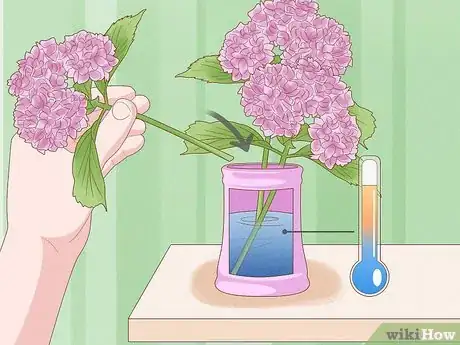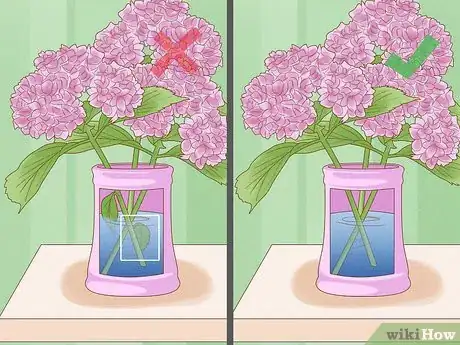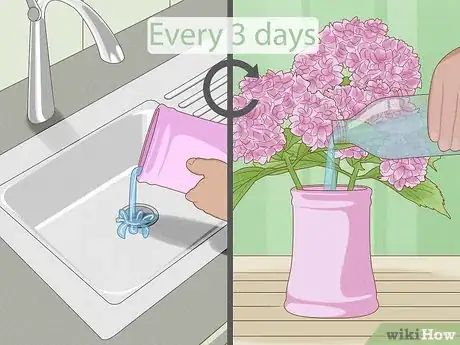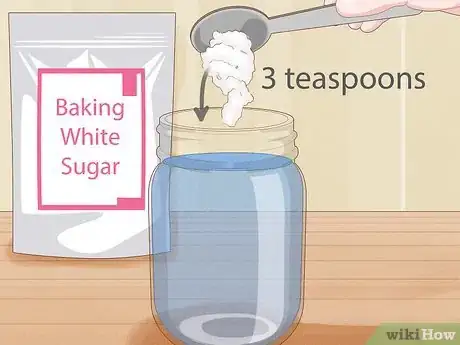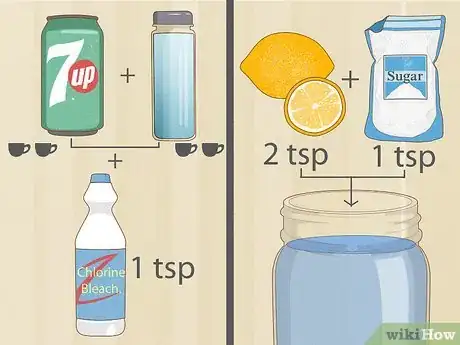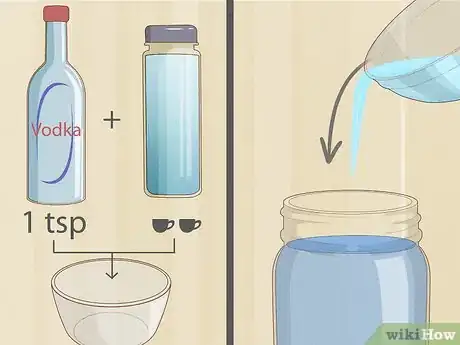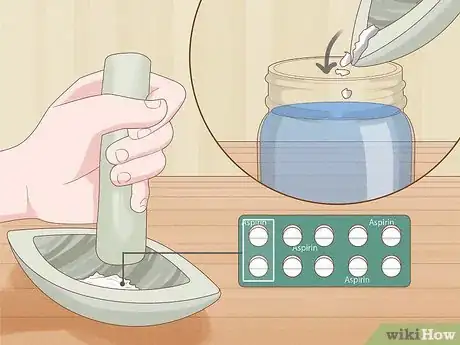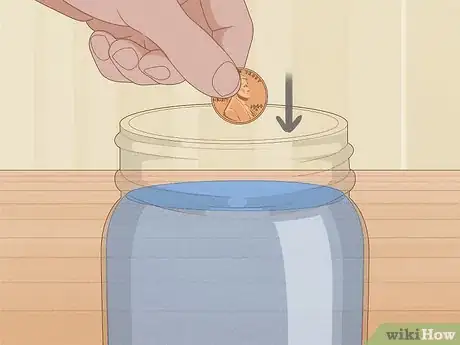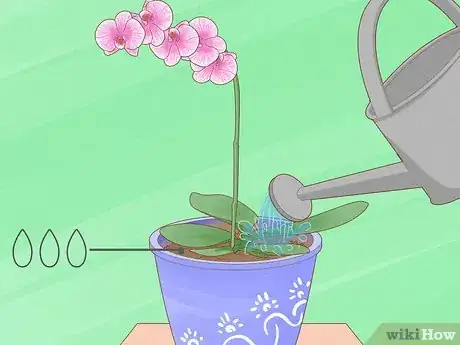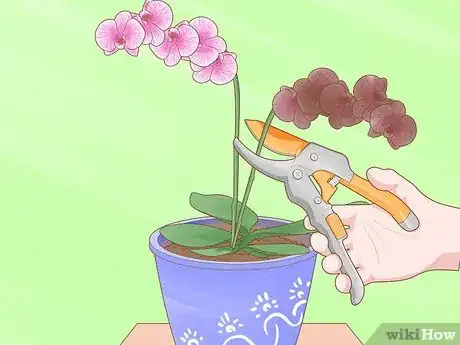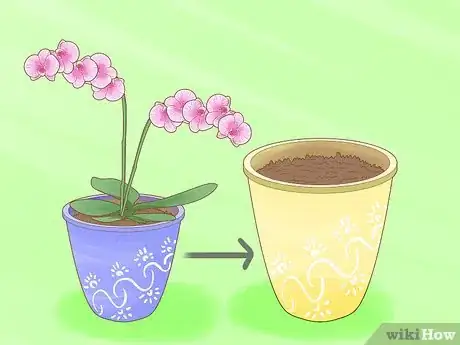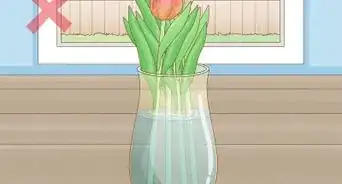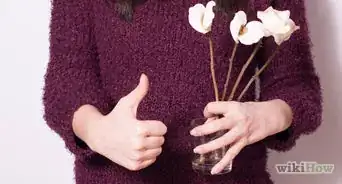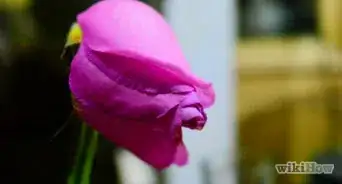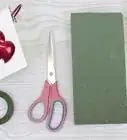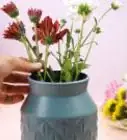This article was co-authored by Pilar Zuniga. Pilar Zuniga is a Floral Designer and the Owner of Gorgeous and Green, a floral design studio and Certified Green Business based in Oakland, California. Pilar has over ten years of experience in floral design. With a focus on being earth-friendly and supporting local growers, Gorgeous and Green has been featured in Energy Upgrade California, Molly My, Apartment Therapy, 100 Layer Cake, Design Sponge, and Trendy Bride. Her studio provides floral arrangements and gift basket, event and wedding design, and she teaches workshops on flower design and sustainability in her industry. Pilar received a BA in Anthropology from the University of California, Berkeley in 2001.
There are 8 references cited in this article, which can be found at the bottom of the page.
This article has been viewed 226,434 times.
Though a bouquet of flowers can make a lovely gift, you may notice your flowers starting to wilt after a few days in their vase. Don’t be so quick to throw them away--there are several steps you can take to help perk up the flowers and make them appear fresh again. You may also want to perk up potted flowers indoors or in your garden so they stay fresh and healthy.
Steps
Trimming and Maintaining Cut Flowers
-
1Cut one inch off the stems at an angle. Cut flowers may look great in a vase in your kitchen but inevitably, bacteria in the water and on the surface of the flowers will clog up the stems. You will need to re-cut the stems to remove the clogged portions of the stem and prevent the flowers from wilting and dying. Use garden shears, pruners, or a sharp knife to make a clean cut at a 45 degree angle. This will ensure the cuts are clean and smooth.
- Cut about 1 inch of the stems, making sure that are the flowers are relatively even in length, as this will ensure they all perk up at the same time.
EXPERT TIPPilar Zuniga is a Floral Designer and the Owner of Gorgeous and Green, a floral design studio and Certified Green Business based in Oakland, California. Pilar has over ten years of experience in floral design. With a focus on being earth-friendly and supporting local growers, Gorgeous and Green has been featured in Energy Upgrade California, Molly My, Apartment Therapy, 100 Layer Cake, Design Sponge, and Trendy Bride. Her studio provides floral arrangements and gift basket, event and wedding design, and she teaches workshops on flower design and sustainability in her industry. Pilar received a BA in Anthropology from the University of California, Berkeley in 2001.Floral Designer & Owner, Gorgeous and Green
 Pilar Zuniga
Pilar Zuniga
Floral Designer & Owner, Gorgeous and GreenOur Expert Agrees: If your flowers are weeping, or the heads are nodding, try putting a needle through the base, right underneath the head of that flower. That will help perk roses back up about 90% of the time. If that doesn't work, hold the stem underwater and cut off the very bottom of the stem to try to help the flower absorb water better.
-
2Place the cut stems in fresh, lukewarm water. Do this as soon as the stems have been cut to prevent air bubbles from becoming trapped in the stems. The air bubbles can block the flow of water up the stems and lead to wilted, dying flowers.[1]
- Though some florists advocate for the use of cold water or warm water, lukewarm water will help to revive the flowers just as well. Warm water can bring moisture to the flowers faster, but may shock the flowers and lead to wilting.
- The exceptions to this rule are bulbs like tulips and hyacinths. These flowers prefer cold water.
Advertisement -
3Remove any leaves below the water line. Leaves that sit in the water or fall into the water can foul up the water as they rot and deteriorate. Only remove leaves that sit below the water line in the vase of water as higher leaves can help to pump water to the stems.
- You should also remove any other debris that is sitting in the water, such as fallen petals or bugs. This debris can introduce bacteria into the water that can cause the flowers to wilt.
-
4Keep the flowers in a cool, dark spot. The cooler and darker the environment around your flowers, the longer they will live. Avoid placing them in direct sunlight. Look for a spot in your home that is cool in temperature and does not get a lot of light.[2]
- The exception to this rule is sunflowers, which often need more light than other cut flowers.
- You should also keep the flowers away from ripening fruit, such as bananas. Ripening fruit give off a gas called ethylene, which can significantly shorten the lifespan of your flowers.
-
5Replace the flower water every three days. Keep your flowers looking fresh by replacing the flower water with fresh water every three days. The rule is, if you wouldn’t drink the vase water yourself, it probably isn’t clean enough for your flowers.[3]
- If there seems to be a lot of gunk and debris in the flower vase, you may want to quickly rinse out the flower vase before replacing the water and putting the flowers back in the vase. A clean vase will prevent bacteria from infecting your flowers.[4]
Adding Products to the Flower Water
-
1Put floral preservative in the water. Most cut flower bouquets come with a pack of floral preservative that you can mix into the flower water. You should always add this into the water to keep the flowers perky and fresh.
- Follow the directions on the package to make sure you are using the correct amount of floral solution per the amount of water in the vase. Too much water can result in a diluted solution and too little water can result in a solution that is too strong for the flowers.
- Floral preservatives are effective because they provide food for the flowers in the form of sugar, they contain ingredients that kill bacteria and fungi, and they acidify the water.
-
2Add three teaspoons of sugar to the water. Sugar can help to feed the flowers and perk them up. You can use baking white sugar and stir it into the vase water so it combines well.[5]
- You can also add one to two teaspoons of white vinegar to the water in addition to the sugar. Vinegar can help to get rid of bacteria in the water that could weaken the flowers.[6]
-
3Make a citrus based soda and bleach mixture. A citrus based soda like 7-UP can provide acidity and sugar for the flowers, which can help them to stay fresh. To combat the bacteria growth in the flower water, you can also add a small amount of bleach. This mixture can help to prolong the lifespan of the flowers and prevent bacteria growth in the flower water.[7]
- To create a citrus based soda and bleach mixture, you can combine two cups of soda (not diet) with two cups water. Add one teaspoon household chlorine bleach. Mix well and place the freshly cut flowers into the mixture.
- You can also use two tablespoons lemon juice and one tablespoon sugar instead of two cups soda if you do not have access to soda.
-
4Add diluted vodka to the water. Vodka can help to prevent the production of ethylene gas, which can cause wilting. You will need to dilute the vodka to avoid poisoning the flowers.[8]
- Add 1 tablespoon vodka to one to two cups of water.
-
5Try adding crushed Aspirin to the water. Aspirin contains nitric oxide, which can help to slow down the dying process in plants. To try this method, crush 1 mg or two tablets of Aspirin and let it dissolve into the water.[9]
- Viagra will also work the same way as it contains nitric oxide.
- In one test of the Aspirin method, the flower heads stayed perky until day 5 of the trial and the stems of the flowers turned gray.[10]
-
6Put a copper penny in the water. The copper in the penny can act as an antibacterial agent and prevent the growth of bacteria that could weaken the flowers. Make sure the copper penny is clean before putting it into the flower water.[11]
Caring for Potted Flowers
-
1Give the potted flowers more water if the top soil is dry. Outdoor flowers and plants often wilt due to a lack of moisture and a lack of water. This is especially common if it has been hot and dry outside, as the plant may need to use more water in its soil to stay hydrated. Check if the top soil is dry by sticking your forefinger into the soil so it is a few inches into the soil. If the soil is dry to the touch, the plant likely needs a good watering.[12]
- Water the plants in the early morning as this will help them conserve water for the rest of the day. If the flowers are planted in a flower bed, make sure you put mulch around the flowers as this can help to reduce soil evaporation.[13]
- Be generous with the water, as it can be difficult to overwater potted plants, particularly if the pot has good drain holes at the bottom. You should check the potted plants daily in the morning to ensure the top soil is not too dry and water the flowers again if the soil is still dry.
- If the soil appears to have moved away from the sides of the pot and is very dry, you may need to poke small holes into the soil with a pen to ensure the water reaches the plant's roots. If you do not do this, the water could simply flood the sides of the pot and not reach the roots at all.
-
2Trim and remove any deadheads. Deadheads are flower heads that have died or shrivelled up on the stem. You should trim off deadheads with gardening shears to signal to the plant that it is time to release fresh buds. Cut just below the deadheads but avoid trimming off too much of the stem on the plant.[14]
- You should also remove any brown leaves and brown petals to give your flowers a chance to refresh itself.
-
3Add slow-release fertilizer to the soil. You can buy a potting soil mix that contains slow-release fertilizer or you can add slow-release fertilizer to the soil after the flowers have already been potted. Slow-release fertilizer can help the flowers stay healthy, but you may also need to fertilize the plant weekly to keep it looking perky.[15]
- Use water-soluble fertilizer that has a formula of 15-30-15 or 20-10-20. Another option is to alternate with a "bloom booster" formula that is high in phosphorus (10-52-10). This will help to stimulate the growth of new flowers.
-
4Move the flowers to a new pot. If the flowers are really wilting and looking sad, you may want to consider replanting the flowers in a new pot. Use potting soil that contains slow-release fertilizer in your new pot and take the time to water and fertilize the flowers in their new pot. This could give your potted flowers the extra boost they need to stay healthy and vibrant.[16]
- Make sure the pot has good drainage holes so the water can be soaked up by the soil when you water the flowers.
Community Q&A
-
QuestionWhy do pots need drainage holes?
 Community AnswerThe holes allow water in the soil to drain freely and help the roots, the plants' breathing mechanism, to access air. Too much water suffocates the roots and stagnated water can cause the roots to rot. Pots' drainage holes also protect plants from possible overwatering.
Community AnswerThe holes allow water in the soil to drain freely and help the roots, the plants' breathing mechanism, to access air. Too much water suffocates the roots and stagnated water can cause the roots to rot. Pots' drainage holes also protect plants from possible overwatering. -
QuestionAbout the soda mix, bleach will kill flowers, right?
 Community AnswerAs a matter of fact, it won't! Bleach actually kills the bacteria floating around in the vase water. I recommend that you change the water out every 2 days and add new bleach.
Community AnswerAs a matter of fact, it won't! Bleach actually kills the bacteria floating around in the vase water. I recommend that you change the water out every 2 days and add new bleach. -
QuestionCan apple cider vinegar work?
 Community AnswerIt is a natural antiseptic, so yes, but it would need to be diluted. Change the water every 1-2 days and cut the stems at the node to prep them.
Community AnswerIt is a natural antiseptic, so yes, but it would need to be diluted. Change the water every 1-2 days and cut the stems at the node to prep them.
References
- ↑ http://www.teleflora.com/blog/how-to-revive-wilting-in-floral-bouquets/
- ↑ http://www.gardenista.com/posts/tried-and-tested-can-you-make-fresh-flowers-last-longer
- ↑ http://www.scientificamerican.com/article/fact-or-fiction-vodka-citrus-sodas-keep-flowers-fresh/
- ↑ http://www.gardenista.com/posts/tried-and-tested-can-you-make-fresh-flowers-last-longer
- ↑ http://www.teleflora.com/blog/how-to-revive-wilting-in-floral-bouquets/
- ↑ http://www.gardenista.com/posts/tried-and-tested-can-you-make-fresh-flowers-last-longer
- ↑ http://www.scientificamerican.com/article/fact-or-fiction-vodka-citrus-sodas-keep-flowers-fresh/
- ↑ http://www.scientificamerican.com/article/fact-or-fiction-vodka-citrus-sodas-keep-flowers-fresh/
- ↑ http://www.huffingtonpost.co.uk/2012/01/19/viagra-revives-wilting-flowers_n_1215566.html
- ↑ http://www.gardenista.com/posts/tried-and-tested-can-you-make-fresh-flowers-last-longer
- ↑ http://www.gardenista.com/posts/tried-and-tested-can-you-make-fresh-flowers-last-longer
- ↑ http://www.birdsandblooms.com/gardening/flower-gardening/revive-potted-plants/?4
- ↑ http://www.groworganic.com/organic-gardening/articles/perk-up-plants
- ↑ http://www.nj.com/homegarden/garden/index.ssf/2008/07/garden_diary_8.html
- ↑ http://www.nj.com/homegarden/garden/index.ssf/2008/07/garden_diary_8.html
- ↑ http://www.birdsandblooms.com/gardening/flower-gardening/revive-potted-plants/?7
About This Article
To perk up wilting flowers, start by cutting 1 inch off the stems at a 45 degree angle, placing the cut stems in lukewarm water, and removing any leaves below the water line. Then, keep the flowers in a cool, dark spot and replace the water every 3 days. Additionally, if your flowers came with a packet of floral preservative, use it to keep bacteria and fungi away. If you don't have a floral preservative packet, make your own by mixing 3 teaspoons of sugar with 1-2 teaspoons of white vinegar. To learn how to use crushed Aspirin to preserve flowers, keep reading!

